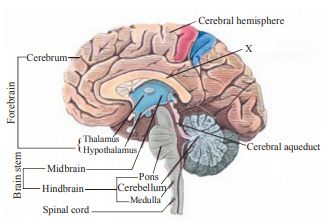The autonomic division of the peripheral nervous system does not innervate:
1. visceral organs
2. exocrine glands
3. skeletal muscle
4. endocrine glands
1. visceral organs
2. exocrine glands
3. skeletal muscle
4. endocrine glands
Four healthy people in their twenties got involved in injuries resulting in damage and death of a few cell of the following. Which of the cells are least likely to be replaced by new cells -
1. Osteocytes
2. Liver cells
3. Neurons
4. Malpighian layer of the skin
One of the examples of the action of the autonomous nervous system is -
1. Knee-jerk reponse
2. Pupillary reflex
3. Peristalsis of the intestines
4. Swallowing of food
Parkinson's disease (characterized by tremors and progressive rigidity of limbs) is caused by degeneration of brain neurons that are involved in movement control and make use of neurotransmitter -
1. Norepinephrine
2. Acetylcholine
3. GABA
4. Dopamine
The number of correct statements amongst the given statements is:
I. Somatic neural system relays impulses from the CNS to smooth muscles of the body.
II. Myelinated nerve fibers are found in spinal nerves but nor in cranial nerves.
III. Sodium-potassium pump transports 3 sodium outwards and 2 potassium into the cell.
IV. Electrical synapses are rare in our system.
V. Efferent neurons carry signals from the CNS to the effector.
1. 2
2. 3
3. 4
4. 5
The structure marked as X in the following diagram showing sagittal section of the human brain would be:
1. Corpora quadrigemina
2. Limbic system
3. Corpus callosum
4. Hippocampal gyrus
In the given diagram of cochlea, the tectorial membrane is represented by the letter:
1. A
2. B
3. C
4. D
The resting axonal membrane of a neuron:
1. is not polarized
2. has excess of anions on the outside
3. is more permeable to potassium ions than to sodium ions
4. cannot be excited by a stimulus
The specific receptor organ in the otolith organ of the internal ear are called as:
1. Macula
2. Crista
3. Cupula
4. Organ of Corti
A canal called as the cerebral aqueduct passes through the:
1. Diencephalon
2. Mid brain
3. III ventricle
4. IV ventricle








